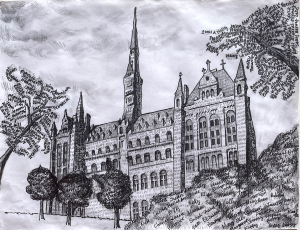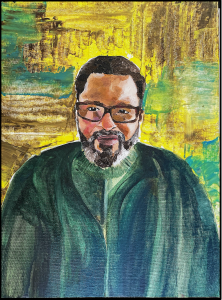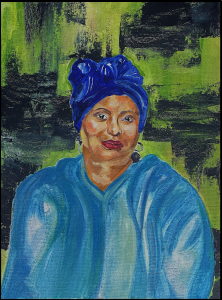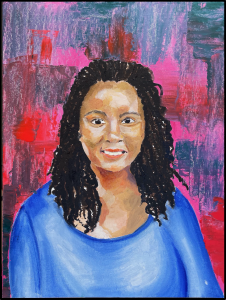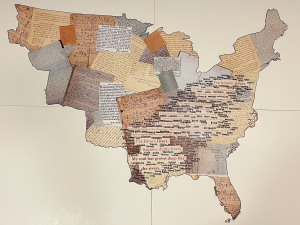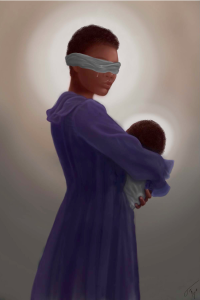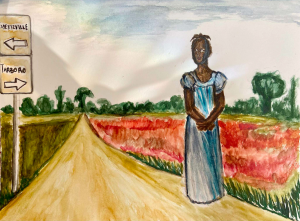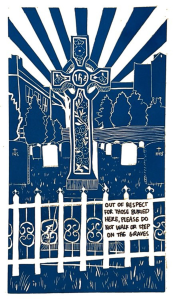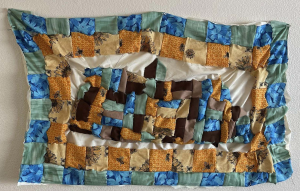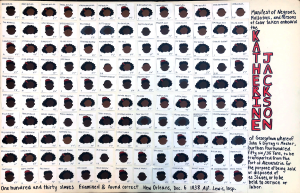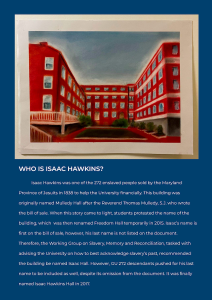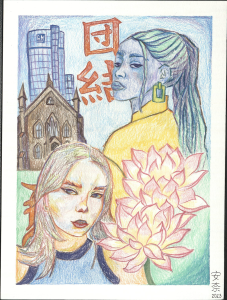Facing Georgetown’s History Through Art presents artwork by undergraduate students in Professor Adam Rothman’s History 099 class from 2021 to 2023. The class focused on Georgetown’s historical connections to slavery and its ongoing Slavery, Memory, and Reconciliation initiatives. The students used archival materials in imaginative ways to humanize the subject matter of the class, and to remind the Georgetown community that names on old documents reflect real people from history. The artwork emphasizes the enduring legacies of slavery for Georgetown, the descendants of the GU272, and the artists themselves.
This exhibition complements "Facing Georgetown's History through Objects," April 11-April 30, 2024.
Write Their Names
Joy Kang (SFS ‘24)
2021
Pencil and ink on paper
Inspired by the Black Lives Matter and #SayHerName movements, Joy Kang inscribes Healy Hall and the trees around it with the names of the 272 enslaved individuals the Jesuits planned to sell in 1838. Healy Hall, one of Georgetown’s iconic buildings, is named for Rev. Patrick Healy, S.J., who was the son of an enslaved woman named Eliza. Healy Hall and the trees bearing the names of the GU272 symbolize the endurance of the legacies of slavery at Georgetown.
We the Descendants: Carlos Scott Portrait
Mozna Alsulayman (CAS ‘22)
2023
Oil painting
This portrait of GU272 descendant Carlos Scott is part of an exhibition proposed by Mozna Alsulayman as a counterpoint to the statue of Georgetown's founder John Carroll, seated at the entrance to campus.
Carlos Scott, descendant of the Hawkins, Butler, Hill, and Scott families, grew up in Maringouin, Louisiana, and now lives in Bowie, Maryland, where he is a pastor and songwriter.
We the Descendants: Mélisande Short-Colomb Portrait
Mozna Alsulayman (CAS ‘22)
2023
Oil painting
This portrait of GU272 descendant Mélisande Short-Colomb is part of an exhibition proposed by Mozna Alsulayman as a counterpoint to the statue of Georgetown's founder John Carroll, seated at the entrance to campus.
Mélisande Short-Colomb, great-great-great-granddaughter of Mary Ellen Queen and Abraham Mahoney, enrolled at Georgetown in 2017 and has borne witness to her experience as a descendant in her one-woman play “Here I Am.”
We the Descendants: Melissa Kemp Portrait
Mozna Alsulayman (CAS ‘22)
2023
Oil painting
This portrait of GU272 descendant Melissa Kemp is part of an exhibition proposed by Mozna Alsulayman as a counterpoint to the statue of Georgetown's founder John Carroll, seated at the entrance to campus.
Melissa Kemp, the great-great-great-great-granddaughter of Louisa Mahoney Mason, is a biologist at the University of Texas at Austin who focuses on ecology and conservation of wildlife.
Sold Down the River
Alexandra Morse (CAS ‘25) and Liv McAuslan (SFS '25)
2022
Newspaper and archive collage
Alexandra Morse and Liv McAuslan’s multimedia collage map of the United States illustrates the impact of the sale of the GU272 in 1838. The artists use Langston Hughes' poem "The Negro Speaks of Rivers" to depict the journey from the Upper South to the Deep South by the Ohio and Mississippi Rivers. The river evokes Black lineage and history. Printed in red, the text of the poem evokes the pain and suffering of the domestic slave trade. The collage is composed of document fragments and images found in the Georgetown Slavery Archive.
A Mother’s Love
Tahis Meza (CAS ‘24)
2022
Digital art
The urgent plea of a pregnant enslaved woman sold in 1838 – “What will become of me? Why do I deserve this?” and the answer from the priest who enslaved her, “Trust in God” – inspired Tahis Meza to portray motherhood in the crucible of slavery. The woman in Meza’s piece wears a blue dress and a gray blindfold: Georgetown’s colors. She resembles the Virgin Mary, alluding to the intersections of Catholicism and slavery.
Untitled
Eva Davis (CAS ‘22)
2021
Watercolor on paper
Eva Davis’s watercolors bring to life the humanity of freedom seekers described in runaway advertisements placed by enslavers. Watercolor captures the vibrant spirit of the freedom seekers. In this painting, Davis depicts the flight of a woman named Judy who escaped her enslaver in Fayetteville, North Carolina in 1829, possibly to return to her birthplace “from whence she was brought by a speculator.”
The Truth Lies Below
Anjul Bhangu (CAS ‘23)
2022
Linoleum linocut and ink on paper
Anjul Banghu’s prints demonstrate the persistence of racism and inequality at Georgetown.
The image of the Jesuit graveyard starkly contrasts with the neglect of the College Burial Ground, which included graves of enslaved people. The second print incorporates symbols that connect Georgetown with slavery; the phrase “Slavery Is Good” comes from the writing of Brother Joseph Mobberly, S.J. (1779-1827).

The True Colors of Georgetown
Reagan Crittenden (CAS ‘22)
2021
Quilting with cotton
Reagan Crittenden’s quilt depicts the relationship between generations of enslaved people and the emergence of Georgetown symbolized by Healy Hall. Crittenden uses blues, greens, and browns to represent the experience of slavery, while she surrounds Georgetown’s Healy Hall in whiteness. Healy Hall itself is a patchwork of all of these colors. Crittenden’s piece pays homage to Black women’s quilting traditions.
Untitled, 2021
Jem Dyson (CAS ‘22)
2021
Cardstock and Sharpie on poster board. Graphics made in Adobe Illustrator.
Jem Dyson humanizes the historical archives with this re-imagining of the ship manifest of the Katherine Jackson. The manifest listed the people sold by the Jesuits in 1838 and held captive on board the Katherine Jackson during its three-week journey from Alexandria to New Orleans. Dyson’s images offer visual cues signifying the age, sex, and color of the Katherine Jackson’s enslaved passengers. The array of figures preserves the manifest's order to emphasize their family ties.
Isaac Hawkins Hall Marker
Peyton Kelleher (CAS ‘24)
2022
Conté crayon
In 2017, Georgetown renamed Mulledy Hall after Isaac Hawkins, the first person listed in the 1838 bill of sale of the GU272. Nevertheless, many Hoyas do not know the history behind the new name. Peyton Kelleher accompanies a conté crayon drawing of Isaac Hawkins Hall with text explaining who Isaac Hawkins was and how the building, once named for Reverend Thomas Mulledy, S.J. (1794-1860) who orchestrated the 1838 sale, came to be named for Isaac Hawkins.
Envisioning a Stronger Future Together: Black and Japanese Unity in Detroit
Anna Broderick (SFS ‘26)
2023
Colored pencil on paper
Anna Broderick envisions unity between the Japanese American and Black communities in her hometown of Detroit, blending historical realism and symbolic imagery inspired by the murals of Diego Rivera. The images of the women are offset by two Detroit landmarks, the Second Baptist Church and the Renaissance Center, and lotus flowers that represent regeneration.
The Library would like to thank Professor Adam Rothman for curating this exhibit and for his continued partnership and support for the Library. We would also like to thank Isabel Corvington (CAS ' 26) for her extensive assistance with this exhibition.

